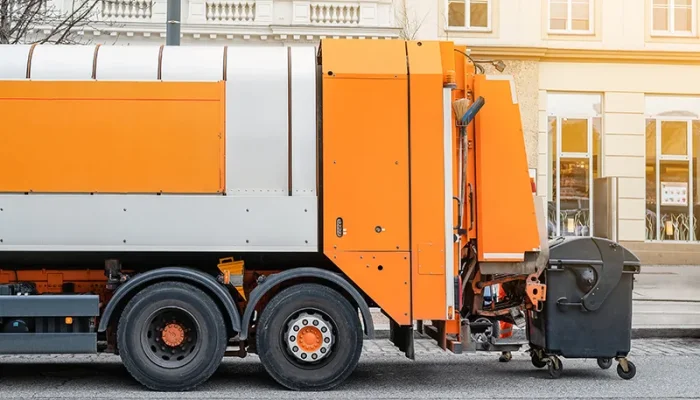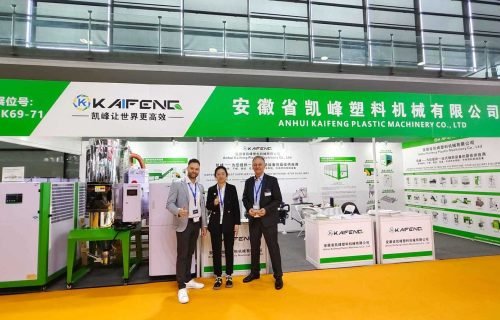Herstellung von Gummi und Verbundwerkstoffen
Kaifeng ist ein professioneller Hersteller von Kunststoffmaschinen, der die Forschung und Entwicklung, die Herstellung und den Vertrieb von Maschinen für die Kunststoffperipherie integriert.
Grundlegende Anforderungen
1. Konsistenz der materiellen Leistung
Eine präzise Kontrolle der Eigenschaften von Rohstoffen ist nicht verhandelbar. Gummimischungen erfordern exakte Polymer-Füllstoff-Zusatzverhältnisse für gleichbleibende Elastizität, Reißfestigkeit und Alterungsbeständigkeit. Verbundwerkstoffe erfordern wiederholbare Faser-Harz-Grenzflächen, um mechanische Eigenschaften wie Zugfestigkeit und Schlagfestigkeit zu gewährleisten. Die Gleichmäßigkeit von Charge zu Charge hat direkte Auswirkungen auf die Produktsicherheit in kritischen Anwendungen (z. B. Reifen, Komponenten für die Luft- und Raumfahrt).
2. Prozessparameter-Genauigkeit
Die strikte Einhaltung der thermischen und mechanischen Parameter bestimmt die Produktintegrität. Die Vulkanisation von Kautschuk erfordert eine exakte Temperatur- (±1°C) und Zeitsteuerung, um eine optimale Vernetzung zu erreichen. Härtungszyklen von Verbundwerkstoffen erfordern präzise Temperaturrampen und Druckprofile, um Hohlräume oder Delaminationen zu vermeiden. Echtzeit-Überwachungssysteme sind unerlässlich, um diese Toleranzen während der gesamten Produktion aufrechtzuerhalten.
3. Rigorose Umweltkontrolle
Das Feuchtigkeits- und Kontaminationsmanagement ist entscheidend. Hygroskopische Materialien (z. B. mit Kieselsäure gefüllter Gummi, Nylonverstärkungen) benötigen während der Verarbeitung Taupunkte unter -40 °C, um Dampfporen oder Hydrolyse zu vermeiden. Reinräume oder geschlossene Systeme verhindern, dass Verunreinigungen aus der Luft die Klebeverbindungen in Verbundwerkstoffen beeinträchtigen oder Defekte an der Gummioberfläche verursachen.
4. Nachhaltige Herstellungspraktiken
Ressourceneffizienz und Abfallreduzierung bestimmen die betriebliche Rentabilität. Energierückgewinnung aus exothermen Reaktionen (z. B. Gummiaushärtung), geschlossene Wasserkühlsysteme und die Verwendung von Mahlgut (≥30% bei unkritischen Verbundwerkstoffen) senken die Kosten und erfüllen gleichzeitig die ESG-Ziele. VOC-arme Formulierungen und lösungsmittelfreie Prozesse erfüllen die Emissionsvorschriften.
Schmerzpunkt

Hindernisse für die Integration der Automatisierung
Hindernisse für die Integration der Automatisierung
Verstärkungslage und Gummiprofilextrusion widerstehen der vollständigen Automatisierung. Die manuelle Platzierung der Verbundlagen erreicht eine Wiederholbarkeit von <60%. Die variable Elastizität des Gummis führt zu Ungenauigkeiten beim Aufquellen der Düse während der Extrusion. Die Nachrüstung älterer Anlagen mit IoT-Sensoren stößt auf Kompatibilitätshürden.

Belastungen durch die Einhaltung von Vorschriften
Sich entwickelnde Normen (REACH, EPA VOC-Grenzwerte) erfordern ständige Neuformulierungen. Für Kautschukbeschleuniger wie MBT gelten Nutzungsbeschränkungen, die alternative Vulkanisationssysteme erfordern. Zusammengesetzte Emissionen (Styrol, Aceton) erfordern kostspielige Auffangsysteme. Die Dokumentation für die Zertifizierung in der Luft- und Raumfahrt sowie im medizinischen Bereich verursacht zusätzliche 20-35%-Kosten.

Materialinkonsistenz und Lieferschwankungen
Rohpolymerchargen (Naturkautschuk, Harze) weisen aufgrund von Schwankungen in der Quelle Eigenschaftsschwankungen auf. Füllstoffe wie Ruß oder Kieselerde erfordern eine strenge Dispersionskontrolle, um Agglomeration zu verhindern. Verbundwerkstoff-Verstärkungen (z. B. Glas-/Kohlenstofffasern) können unter uneinheitlichen Schlichteverfahren leiden, die die Harzhaftung beeinträchtigen. Diese Unstimmigkeiten führen zu kostspieligen Nachbearbeitungen und Qualitätsabweichungen.

Herausforderungen im Wärmemanagement
Die genaue Steuerung der exothermen Reaktion bleibt problematisch. Bei der Vulkanisation von Kautschuk kommt es zu einer ungleichmäßigen Wärmeverteilung, was zu unterhärteten Kernen oder einer Verbrennung der Oberfläche führt. Die Aushärtung von Verbundwerkstoffen erfordert exakte Temperaturgradienten; Abweichungen von mehr als ±3°C führen zu Harzschrumpfung oder Delamination. Die effiziente Kühlung großer Formen ist mit einem hohen Energieaufwand verbunden und kostet Zykluszeit.
Lösungen in der Kunststoffverarbeitung Lösungen
Überblick über die Lösung
Die Kunststoffmaschine nutzt effiziente Wärmemanagement-Technologien, wie z. B. eine Doppelfunktions-Temperaturregelung und Wärmerückgewinnungssysteme, um energieeffiziente Heiz- und Kühlprozesse zu erreichen. Echtzeitüberwachung und programmierbare Steuerungen gewährleisten die Genauigkeit und Stabilität des Produktionsprozesses, während automatisierte Betriebsverfahren menschliche Eingriffe reduzieren und die Produktionseffizienz verbessern.

Details zur Lösung
Optimiertes Wärmemanagement
Doppelfunktionale Temperaturregelung ermöglicht nahtlose Heiz-/Kühlübergänge in Werkzeugtemperiergeräten. Wärmerückgewinnungssysteme in Entfeuchtern dienen der Wiederverwendung von Wärmeenergie, wodurch der Nettoenergieverbrauch bei der Materialverarbeitung reduziert wird.
Stabilisierte Prozesssteuerung
Echtzeitüberwachung und programmierbare Steuerungen sorgen für die Einhaltung präziser Parameter (Temperatur, Feuchtigkeit, Mischungsverhältnisse). Selbstdiagnosesysteme erkennen automatisch Anomalien bei kritischen Vorgängen, um Abweichungen zu vermeiden.
Automatisierte Betriebsverfahren
Voreingestellte Programme für Kunststoffmaschinen automatisieren die Materialdosierung und Feuchtigkeitsregelung. Die Fernüberwachung ermöglicht eine zentrale Steuerung der Geräte, während visuelle Anzeigen und Alarmsysteme das menschliche Eingreifen minimieren.
Maßgeschneiderte Erweiterung des Produktionsumfangs
Der modulare Aufbau der Kunststoffmaschinen passt sich an verschiedene Maßstäbe an (von F&E bis zur Großproduktion). Konfigurierbare Parameter unterstützen kundenspezifische Prozesse wie die Gummivulkanisierung. Die maßgeschneiderte Konstruktion gewährleistet eine nahtlose Integration der Arbeitsabläufe.
Vorteile in Recycling und Abfallwirtschaft

Globaler Service und starker Kundenzuspruch
Globaler Service und starker Kundenzuspruch Unsere Geräte werden in über 20 Länder und Regionen in Europa, Nord- und Südamerika, Afrika und Südostasien exportiert. Mit mehr als 500 Unternehmenskunden weltweit und einer Wiederkaufsrate von 85% haben wir ein solides globales Netzwerk und einen vertrauenswürdigen Ruf in der Branche aufgebaut.

Breite Palette von Anwendungen
Breite Palette von Anwendungen Unsere Produkte und Lösungen werden in vielen verschiedenen Branchen eingesetzt, z. B. in der Kunststoffverarbeitung, im Recycling und in der Abfallwirtschaft, in der chemischen und pharmazeutischen Produktion, in der Lebensmittel- und Getränkeindustrie, in der Heizungs-, Lüftungs- und Klimatechnik sowie in der Gummi- und Verbundwerkstoffherstellung. Dies beweist unsere außergewöhnliche Anpassungsfähigkeit.

Umfassende Branchenabdeckung
Wir sind im Bereich der Kunststoffhilfsmittel stark vertreten und bieten ein komplettes Portfolio, das Wärme- und Kältetausch, Zerkleinerung und Recycling, Mischen und Dosieren, Entfeuchten und Trocknen sowie Beschickungs- und Fördersysteme umfasst. Unsere breite Produktpalette ist so konzipiert, dass sie den Anforderungen der verschiedenen Produktionsstufen gerecht wird.

Gleichbleibende Qualität und lange Nutzungsdauer
Wir arbeiten nach dem internationalen Qualitätsmanagementsystem ISO9001 und verwenden hochwertige Materialien wie gehärtete Legierungsblätter und Motoren mit Kupferkern. In Kombination mit fortschrittlichen Prüfgeräten gewährleisten diese eine stabile Leistung und verlängern die Lebensdauer der Geräte um bis zu 50%.

Wettbewerbsfähige Preisgestaltung und flexible Anpassung
Wettbewerbsfähige Preise und flexible Anpassungsmöglichkeiten Unsere Produkte sind 10%-15% preisgünstiger als vergleichbare Geräte, ohne dass die Qualität darunter leidet. Wir bieten maßgeschneiderte Anpassungen, flexible Zahlungsoptionen und langfristige Garantien, um die Investitionsrendite für unsere Kunden zu maximieren.

Fortschrittliche Forschung und Entwicklung und technisches Fachwissen
Fortschrittliche F&E und technisches Know-how Wir verfügen über ein eigenes F&E-Zentrum und eine Technologieabteilung, die mit modernen Produktionslinien und fortschrittlichen Prüfsystemen ausgestattet sind. Unsere erfahrenen Ingenieure verbessern ständig die Produktleistung und entwickeln neue, auf die Marktanforderungen zugeschnittene Lösungen.
Verarbeitbare Kunststoffarten
PP
PP
PVC
PVC
PE
PE
PC
PC
PS
PS
PET
PET
Erhalten Sie eine maßgeschneiderte Lösung
Als professioneller Hersteller von Kunststoffmaschinen sind wir für alle Arten von Beratungen offen.
Kontakt US
FAQ
Wie sorgt Ihre Kunststoffmaschine für eine gleichmäßige Mischung der Gummimischung?
Unsere Mischsysteme ermöglichen eine präzise Steuerung des Füllstoffverhältnisses und eine gleichmäßige Dispersion - entscheidend für das Erreichen der erforderlichen mechanischen Eigenschaften von Gummiprodukten. Durch die automatische Dosierung wird die Konsistenz von Charge zu Charge für eine hochwertige Vulkanisation aufrechterhalten.
Welche Möglichkeiten der Temperaturkontrolle unterstützen die Aushärtung von Verbundwerkstoffen?
Unsere Temperaturmanagementsysteme liefern stabile Heizprofile, die für die ordnungsgemäße Aushärtung von Harz in Verbundwerkstoffen unerlässlich sind. Die Geräte halten enge Temperaturtoleranzen während des gesamten Formgebungszyklus ein.
Wie gehen Ihre Trocknungsgeräte mit feuchtigkeitsempfindlichen Verbundwerkstoffen um?
Die Entfeuchtungssysteme bereiten hygroskopische Verbundwerkstoff-Verstärkungen effektiv vor, indem sie den Feuchtigkeitsgehalt vor der Formgebung auf ein optimales Niveau reduzieren.
Kann Ihre Kunststoffmaschine recyceltes Gummi/Verbundmaterial verarbeiten?
Unsere Zerkleinerungsmaschine für Kunststoffe ist für die Verarbeitung von postindustriellen Gummi- und Verbundstoffabfällen konzipiert und produziert konsistentes Mahlgut, das für die Wiederverwendung in Fertigungsprozessen geeignet ist.
Welche Merkmale gewährleisten eine sichere Verarbeitung von Gummi-/Verbundstoffrezepturen?
Die Anlage umfasst die notwendigen Sicherheitsvorkehrungen für den Umgang mit verschiedenen Gummimischungen und Verbundharzen, einschließlich einer angemessenen Belüftung und Materialeindämmung.
Obligatorische Ausrüstungen

Wärme- und Kälteaustauschgeräte
Temperaturkontrolle in Gummi- und Verbundwerkstoff-Formprozessen.

Misch- und Dosieranlagen
Mischen und Dosieren von Rohstoffen.

Die 13. Internationale Technologiekonferenz der Getränkeindustrie...
KAIFENG Plastic Machinery ist ein professionelles Unternehmen für die Herstellung, den Vertrieb und den Service im Bereich der Ausrüstung und industrielle Temperaturkontrolle...

Analyse und Lösungen für allgemeine Probleme von Kunststoffmischern durch ...
Bei Kunststoffmischern können im täglichen Gebrauch einige allgemeine Probleme auftreten. Anhui Kaifeng Plastic Machinery Co. Ltd. verfügt über jahrelange Erfahrung in der Branche und wird die Ursachen dieser Probleme analysieren und...

CBST 2025 Shanghai: Kaifeng Machinery's One-Stop Automation...
Vom 5. bis 7. März 2025 wird die 13. China International Beverage Industry Science & Technology Exhibition (CBST-2025) in der Halle N1-N3 des Shanghai New International Expo Centre feierlich eröffnet...
